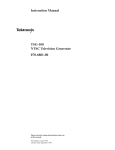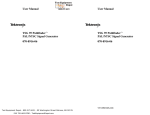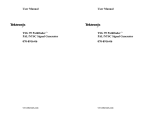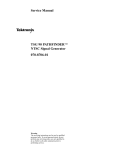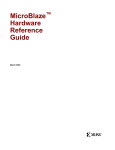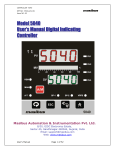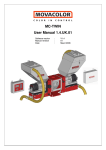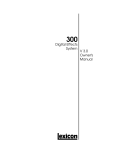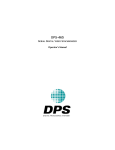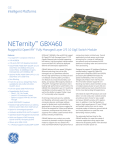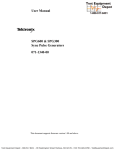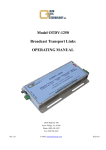Download TEK TSG 90 User
Transcript
User Manual TSG 90 PATHFINDER NTSC Signal Generator 070-8964-00 Please check for change information at the rear of this manual. 30 TSG 90 PATHFINDER User Manual First Printing November 1993 Revised March 1994 Copyright E Tektronix, Inc., 1992, 1993. All rights reserved. Printed in U.S.A. Tektronix products are covered by U.S. and foreign patents, issued and pending. Information in this publication supersedes that in all previously published material. Specifications and price change privileges reserved. The following are registered trademarks: TEKTRONIX and TEK. For further information, contact: Tektronix, Inc., Corporate Offices, P.O. 500, Beaverton, Oregon, 97077 TSG 90 PATHFINDER User Manual 29 Appendix C: User Service 1. Auto power-down; use the left (A ) or right ( ") arrow key to toggle between enabled and disabled. 2. Battery type; use the left (A ) or right ( ") arrow key to toggle between disposable or rechargeable. 3. Factory Reset; press the Enter button to reset the instrument to the factory defaults. WARNING: All user selections will be lost. 4. LCD Diagnostic; press the A key to turn all segments on, and press the " key to turn all segments off. 5. Tone LVL0; used in setting the 0 dBu tone level. See the Service manual (Tektronix p/n 070-8706-00) for the audio amplitude adjustment procedure. 6. Tone LVL4; used in setting the 4 dBu tone level. See the Service manual for the audio amplitude adjustment procedure. 7. Tone LVL8; used in setting the 8 dBu tone level. See the Service manual for the audio amplitude adjustment procedure. Preventive Maintenance Under average conditions, the PATHFINDER should receive preventive maintenance every 2000 hours. This is approximately one year of operation. Preventive maintenance includes cleaning, visual inspection, a performance check and, if necessary, calibration. See the Service manual for performance verification and adjustment procedures. CAUTION. The PATHFINDER case is made of molded plastic. Do not allow water to get inside of any enclosed assembly or component. Do not clean any plastic materials with organic cleaning solvents—benzene, toluene, xylene, acetone, or similar compounds— because they may damage the plastic. 28 TSG 90 PATHFINDER User Manual Warranty Tektronix warrants that the TSG 90 PATHFINDER NTSC Signal Generator will be free from defects in materials and workmanship for a period of one (1) year from the date of shipment. If this product proves defective during the warranty period, Tektronix, at its option either will repair the defective product without charge for parts and labor, or will provide a replacement in exchange for the defective product. In order to obtain service under this warranty, Customer must notify Tektronix of the defect before expiration of the warranty period and make suitable arrangements for the performance of service. Customer shall be responsible for packaging and shipping the defective product to the service center designated by Tektronix, with shipping charges prepaid. Tektronix shall pay for the return of the product to Customer if the shipment is to a location within the country in which the Tektronix service center is located. Customer shall be responsible for paying all shipping charges, duties, taxes, and any other charges for products returned to any other locations. This warranty shall not apply to any defect, failure or damage caused by improper use or improper or inadequate maintenance and care. Tektronix shall not be obligated to furnish service under this warranty a) to repair damage resulting from attempts by personnel other than Tektronix representatives to install, repair or service the product; b) to repair damage resulting from improper use or connection to incompatible equipment; c) to repair any damage or malfunction caused by the use of non-Tektronix supplies; or d) to service a product that has been modified or integrated with other products when the effect of such modification or integration increases the time or difficulty of servicing the product. This warranty is given by Tektronix with respect to this product in lieu of any other warranties, express or implied. Tektronix and its vendors disclaim any implied warranties of merchantability or fitness for a particular purpose. Tektronix’ responsibility to repair or replace defective products is the sole and exclusive remedy provided to the customer for breach of this warranty. Tektronix and its vendors will not be liable for any indirect, special, incidental, or consequential damages irrespective of whether Tektronix or the vendor has advance notice of the possibility of such damages. TSG 90 PATHFINDER User Manual i Appendix C: User Service Battery Hints For optimal battery life and capacity, use the rechargeable NiCad battery pack (Tektronix p/n 119-4488-00) in full charge/discharge cycles. In other words, fully discharge the battery pack before recharging, and then charge the battery pack until fully charged, approximately 16 hours. A new battery pack will take a few charge/ discharge cycles to reach full capacity. WARNING. Install or replace batteries only with the instrument switched OFF, and the AC adapter disconnected. Replace the batteries only with standard AA batteries (1.2–1.5 V, nominal), or with a Tektronix rechargeable battery pack (p/n 119-4488-00). Setting the Battery Type and the Auto Power Down functions in the diagnostic menu also has an impact on battery life. The battery types are disposable (Alkaline) or rechargeable (NiCad). Setting the battery type changes the voltage level that causes the battery low message to be displayed, and also changes the cut-off voltage for instrument operation. The Auto Power Down function, when enabled, shuts the PATHFINDER off when there is no keypress for approximately 10 minutes, to conserve battery life. Auto Power Down is indicated, when enabled, by a rotating line in the upper right corner of the display. The Diagnostic Menu To enter the diagnostic menu, hold the Lock Out button down while turning the instrument on. To exit the diagnostic menu and resume normal instrument operation, press any of the rectangular buttons at the top of the keypad. The diagnostic menu items are listed below. Use the up (Y) and down (B) arrow keys to move up and down the list. ii TSG 90 PATHFINDER User Manual TSG 90 PATHFINDER User Manual 27 Appendix B: Replaceable Parts Contents Warranty . . . . . . . . . . . . . . . . . . . . . . . . . . . . . . . . . . . . . . List of Figures . . . . . . . . . . . . . . . . . . . . . . . . . . . . . . . . . List of Tables . . . . . . . . . . . . . . . . . . . . . . . . . . . . . . . . . . i iii iv Getting Started . . . . . . . . . . . . . . . . . . . . . . . . . . . . . . . . . . . 1 Operating Basics . . . . . . . . . . . . . . . . . . . . . . . . . . . . . . . . . . Controls . . . . . . . . . . . . . . . . . . . . . . . . . . . . . . . . . . . . . . Shift/Shift Lock. . . . . . . . . . . . . . . . . . . . . . . . . Lock Out. . . . . . . . . . . . . . . . . . . . . . . . . . . . . . . Bars and Other Signals. . . . . . . . . . . . . . . . . . . . ID On/Off and ID Menu. . . . . . . . . . . . . . . . . . . ID Edit and ID Position. . . . . . . . . . . . . . . . . . . Tone On/Off and Tone Menu. . . . . . . . . . . . . . . Recall and Store. . . . . . . . . . . . . . . . . . . . . . . . . 3 4 4 5 6 7 7 7 8 Appendix A: Characteristics . . . . . . . . . . . . . . . . . . . . . . . . 9 Appendix B: Replaceable Parts . . . . . . . . . . . . . . . . . . . . . . 25 Appendix C: User Service . . . . . . . . . . . . . . . . . . . . . . . . . . . Battery Hints . . . . . . . . . . . . . . . . . . . . . . . . . . . . . . . . . . The Diagnostic Menu . . . . . . . . . . . . . . . . . . . . . . . . . . . . Preventive Maintenance . . . . . . . . . . . . . . . . . . . . . . . . . . 27 27 27 28 List of Figures Figure 1: Multiburst . . . . . . . . . . . . . . . . . . . . . . . . . . . . . Figure 2: NTC7 Composite . . . . . . . . . . . . . . . . . . . . . . . Figure 3: NTC7 Combination . . . . . . . . . . . . . . . . . . . . . Figure 4: FCC Composite . . . . . . . . . . . . . . . . . . . . . . . . Figure 5: SMPTE Color Bar Signal Components . . . . . . Figure 6: 75% Bars . . . . . . . . . . . . . . . . . . . . . . . . . . . . . . Figure 7: 5-Step Staircase (Gray Scale) . . . . . . . . . . . . . . 26 TSG 90 PATHFINDER User Manual Rev Mar 1994 TSG 90 PATHFINDER User Manual 11 12 13 14 16 17 17 iii head a Figure 8: Red Field . . . . . . . . . . . . . . . . . . . . . . . . . . . . . . Figure 9: Field Square Wave . . . . . . . . . . . . . . . . . . . . . . Figure 10: 50 IRE Flat Field . . . . . . . . . . . . . . . . . . . . . . Figure 11: 0 IRE, No Burst . . . . . . . . . . . . . . . . . . . . . . . Figure 12: Black Burst . . . . . . . . . . . . . . . . . . . . . . . . . . . Figure 13: SINX/X . . . . . . . . . . . . . . . . . . . . . . . . . . . . . . Figure 14: Convergence Signal Components . . . . . . . . . . Figure 15: Matrix . . . . . . . . . . . . . . . . . . . . . . . . . . . . . . . Figure 16: Safe Area Signal Components . . . . . . . . . . . . Figure 17: SNG Bars (Option 1J only) . . . . . . . . . . . . . . 17 18 18 18 19 19 20 20 22 23 Appendix B: Replaceable Parts The following Replaceable parts for the TSG 90 PATHFINDER are available through your local Tektronix, Inc. field office or representative. It is important when ordering parts to include the following information in your order: Part number; instrument type and number; instrument serial number; and modification number, if applicable. Description List of Tables Table 1: Table 2: Table 3: Table 4: Table 5: Table 6: Table 7: Table 8: Table 9: iv Physical Data and Environmental Limits . . . . . Power Requirements/Battery Life . . . . . . . . . . . Test Signal Generator—General Characteristics Audio Tone Output . . . . . . . . . . . . . . . . . . . . . . Multiburst Test Signal . . . . . . . . . . . . . . . . . . . . NTC7 Composite . . . . . . . . . . . . . . . . . . . . . . . . NTC7 Combination . . . . . . . . . . . . . . . . . . . . . . FCC Composite . . . . . . . . . . . . . . . . . . . . . . . . . Remaining Test Signals . . . . . . . . . . . . . . . . . . . 9 10 10 11 11 12 13 14 15 Rev Mar 1994 TSG 90 PATHFINDER User Manual Tektronix Part No. Reference Card 063-1449-00 Service Manual (Optional accessory) 070-8706-00 Rechargeable Battery Pack (Optional accessory) 119-4488-00 Carrying Pouch 016-1229-00 AC Adapter 119-4538-00 Case Assembly, Top 614-0915-00 Case Assembly, Bottom 614-0913-00 Battery Door 200-4075-00 LCD Display 119-4506-00 Rear Panel Assembly 333-4065-00 Fuse 1.5A, 125V 159-0153-00 TSG 90 PATHFINDER User Manual 25 Appendix A: Characteristics Getting Started Please note the following statements before using your new TSG 90 PATHFINDER. CAUTION. Attempting to operate the TSG 90 with an improper AC adapter can result in permanent damage to the instrument. To avoid damage, USE ONLY AN APPROPRIATE DC POWER SOURCE: Voltage must be 9 to 15 VDC; the connector must have the NEGATIVE contact in the center; and open-circuit voltage of the power source must not exceed 18 VDC. For best results, use the AC adapter that is supplied with the instrument. If the supplied adapter is incorrect for the local AC power supply, please contact your nearest Tektronix representative. WARNING. Install or replace batteries only with the instrument switched OFF and the AC adapter disconnected. Replace the batteries only with standard AA batteries (1.2–1.5 V, nominal), or with a Tektronix rechargeable battery pack (p/n 119-4488-00). If you have any questions regarding the operation of this instrument, please contact your nearest Tektronix representative or field office. In the United States and Canada, you may also call the Tektronix information number, 1-800-TEK-WIDE (1-800-835-9433), between 8:00 am and 5:00 pm Pacific time. 24 TSG 90 PATHFINDER User Manual TSG 90 PATHFINDER User Manual 1 Getting Started Appendix A: Characteristics LINES 21 30 IRE Flat Field 163 164 – 198 199 – 209 210 SMPTE Color Bars SMPTE IYQB 30 IRE Flat Field 262 Figure 17: SNG Bars (Option 1J only) 2 TSG 90 PATHFINDER User Manual Rev Mar 1994 TSG 90 PATHFINDER User Manual 23 Appendix A: Characteristics Operating Basics The TEKTRONIX TSG 90 PATHFINDER TV Signal Generator is designed for ease of operation and outstanding portability. It provides a complement of 16 NTSC test signals, including the Safe Area signal. It also provides 13 selectable audio frequencies from 50 Hz to 20 kHz, a 50 Hz to 20 kHz audio sweep, and an audio click channel ID. The two stereo AUDIO outputs may be set to one of three selectable amplitudes: 0 dBu, +4 dBu, or +8 dBu. Figure 16 (cont.): Safe Area Signal Components 22 TSG 90 PATHFINDER User Manual The PATHFINDER provides character ID capability, as well, storing up to eight messages consisting of two 16 character lines of text. Any one of these text messages may be inserted into the video test signal, or up to four of them may be cycled in a continuous loop (displaying for 1 to 9 seconds each) in any order. These messages may be displayed anywhere in the safe action area of the pic- TSG 90 PATHFINDER User Manual 3 Operating Basics Appendix A: Characteristics ture, or the first line of the message may be moved into the vertical interval. In addition to the eight text messages, the PATHFINDER can also store as many as four complete front-panel configurations (user presets), which can include menu selections, text messages, and tone and cycle information. You may power the PATHFINDER with the standard AC adapter, the optional 9.6 V NiCad battery pack, or with eight standard AA batteries. AA batteries are not supplied with the instrument. H Remember that attempting to operate the TSG 90 with an improper AC adapter can result in permanent damage to the instrument. USE AN APPROPRIATE DC POWER SOURCE ONLY: Voltage must be 9 to 15 VDC; the connector must have the NEGATIVE contact in the center; and open circuit voltage of the power source must not exceed 18 VDC. For best results, use the AC adapter that is supplied with the instrument. H The optional NiCad battery pack may be recharged without removing it from the instrument. The AC adaptor will provide a “trickle” charge to the pack whenever the adaptor is connected to the PATHFINDER and an AC power source. H Rechargeable AA batteries may be used, but they will not be recharged when in the instrument. To recharge AA batteries, remove them from the PATHFINDER and use any appropriate charger. Controls PATHFINDER controls consist of a keypad, which has buttons to make operational selections and entering menus; alphanumeric buttons for text entry and test signal selection; and arrow buttons for maneuvering through the menus and positioning text on screen. There is an enter button in the center of the arrow keys, used in menu selections. There is also a Shift/Shift Lock button, an ON button, and a Lock Out button. Shift/Shift Lock. The Shift/Shift Lock button is used to access the upper (shifted) nomenclature associated with each of the buttons, including itself. When Shift is pressed, a reverse video S is dis- 4 TSG 90 PATHFINDER User Manual Figure 16: Safe Area Signal Components TSG 90 PATHFINDER User Manual 21 Appendix A: Characteristics Operating Basics Figure 14: Convergence Signal Components played in the lower right corner of the LCD display, indicating that the next keystroke will use the shifted nomenclature. If the next keystroke is the Shift button again, then the keypad is locked into the shift mode and all keystrokes will use the shifted nomenclature. The LCD display shows a reverse video SL, indicating that shift lock is active. Shift Lock is cancelled by pressing the Shift button a third time. Lock Out. The Lock Out button is used to disable the keypad. While locked out, pressing any key (except Lock Out or ON) produces the message “press Lock Out” on the LCD display and has no other effect. While in Lock Out mode, a lock symbol (padlock icon) appears in the lower right corner of the LCD display. Holding the Lock Out button down while switching the instrument on will invoke the diagnostic menu. See Appendix C (page 27) for more information. Figure 15: Matrix 20 TSG 90 PATHFINDER User Manual TSG 90 PATHFINDER User Manual 5 Operating Basics Appendix A: Characteristics Bars and Other Signals. The Bars and Other Signals buttons are used, along with the alphanumeric keys, for selecting test signals. This occurs in the Signal Select mode; the default operating mode for the PATHFINDER. The PATHFINDER powers up in this mode, and returns to it after exiting any of the other modes. While in the Signal Select mode, the Bars button selects SMPTE Bars and 75% Bars, and the Other Signals button scrolls through the remaining test signals. The arrow keys will also scroll forward and backward through the signal list. In addition, the alphanumeric keys may be used to select signals directly, eliminating the need to scroll through all the signals to get to the one you want: Figure 12: Black Burst Direct Signal Selection List A=SMPTE Bars I=Field Square Wave B=75% Bars J=50 IRE Flat Field C=Multiburst K=0 IRE No Burst D=NTC7 Composite L=Black Burst E=NTC7 Combination M=SIN X/X F=FCC Composite N=Convergence G=5 Step O=Matrix H=Red Field P=Safe Area Option 1J Direct Signal Selection List SN B021565 and Above 6 A=SMPTE Bars I=Red Field B=75% Bars J=Field Square Wave C=SNG Bars K=50 IRE Flat Field D=Multiburst L=Black Burst E=NTC7 Composite M=SIN X/X F=NTC7 Combination N=Convergence G=FCC Composite O=Matrix H=5 Step P=Safe Area Rev Mar 1994 TSG 90 PATHFINDER User Manual Figure 13: SINX/X TSG 90 PATHFINDER User Manual 19 Appendix A: Characteristics Operating Basics ID On/Off and ID Menu. The ID On/Off button toggles the character ID messages (captions) on and off. The LCD display will read ID=off, ID=on for a single text ID message, or ID=cyc if cycle has been turned on in the ID Menu. The ID Menu is accessed by pressing the Shift button before pressing the ID On/Off button. The ID Menu allows the ID cycle to be turned on or off, sets the display time for the captions, and selects which of the stored ID messages to cycle in what order. ID Edit and ID Position. Pressing the ID Edit button enters a mode where the current ID text can be edited. Editing occurs off-line, in an edit buffer, so any displayed messages are not affected. When finished editing, pressing the Enter button saves the ID from the edit buffer as the current ID, and the new text is inserted into the video signal, unless the ID cycle function is in use. Figure 9: Field Square Wave The ID Position mode (Shift–ID Edit) allows positioning of the message on screen. The H and V readouts on the LCD display allow the operator to determine where the message is being positioned, even if there is no video display available. The H value shows how many letter spaces from the left edge the message starts. The V value shows the character line that the first line of text occupies. If the first line of text is placed into the vertical interval, the LCD display will read V=vert. Figure 10: 50 IRE Flat Field Tone On/Off and Tone Menu. The Tone On/Off button toggles the audio tone on and off. When Tone is On, the LCD display will display the selected audio level (for example, Tone=4dB). The Tone Menu (Shift–Tone On/Off) is used to select the tone frequency, select the audio level (0, +4, or +8 dBu), and to turn the audio click on and off. The tone frequency menu will select one of 13 fixed frequencies between 50 Hz and 20 kHz, or a 50 Hz–20 kHz audio sweep. This sweep signal is composed of 27 separate frequencies, more than double the number of specified fixed frequencies. While in the tone frequency menu, with sweep selected (displayed on the LCD readout), pressing the ENTER key will stop the sweep and the PATHFINDER will continue to output the frequency it was producing when the ENTER key was pressed. The display will change from SWEEP 50–20K to SWEEP PAUSED. This is useful for checking Figure 11: 0 IRE, No Burst 18 TSG 90 PATHFINDER User Manual Rev Mar 1994 TSG 90 PATHFINDER User Manual 7 Operating Basics Appendix A: Characteristics a problem noticed at a particular frequency while sweeping, and also allows the use of frequencies not specifically addressed in the Tone Menu. Pressing the ENTER key again will restart the sweep. Recall and Store. The Recall button allows the user to recall one of eight user-defined IDs or four user presets. In this mode, the left/ right arrows select the ID or preset number, and pressing ENTER will then recall it. The up and down arrow buttons may be used to view the second line of the text message before recalling. Store is used to store the current ID text with an assigned ID number, or it will store the current text and instrument settings as a user preset. Figure 6: 75% Bars Figure 7: 5-Step Staircase (Gray Scale) Figure 8: Red Field 8 Rev Mar 1994 TSG 90 PATHFINDER User Manual TSG 90 PATHFINDER User Manual 17 Appendix A: Characteristics Appendix A: Characteristics This appendix contains information about the TSG 90 and its output that the operator may find useful. Included are illustrations of the various test signal waveforms and, where helpful, accompanying tables. Signal timing information appears on each figure; the corresponding table—if any—contains nominal amplitude values that may not be apparent in the figure. See the TSG 90 Service Manual, Tektronix p/n 070-8706-00, for more complete descriptions of the test signals. NOTE. The information in this section is included for the convenience of the TSG 90 operator. It is not intended as a list of guaranteed specifications or performance requirements. For a full listing of PATHFINDER specifications, and complete performance verification and adjustment procedures, please see the TSG 90 Service Manual. Table 1: Physical Data and Environmental Limits Characteristic Nominal Value/Limits Height 5.6 cm (2.2 in) Width 9.1 cm (3.6 in) Depth 19.1 cm (7.5 in) Weight without batteries with battery pack 0.48 kg (1.06 lb) 0.68 kg (1.5 lb) Temperature Limits Operating Storage (w/o batteries) 0° to +50° C (32 to +122° F) –30° to +65° C (–22 to +149° F) Altitude Limits Operating Storage to 4267 m (14,000 feet) to 15420 m (50,000 feet) Figure 5: SMPTE Color Bar Signal Components 16 TSG 90 PATHFINDER User Manual TSG 90 PATHFINDER User Manual 9 Appendix A: Characteristics Appendix A: Characteristics Table 2: Power Requirements/Battery Life Characteristic Information DC Input Voltage Range Polarity 9 to 15 V NEGATIVE CENTER Typical Battery Life Alkaline Cells Rechargeable Pack 10 to 16 hours 4 to 6 hours Approximately 16 hours (completely discharged to fully charged) Recharging Time Table 3: Test Signal Generator—General Characteristics 10 Characteristic Specification Luminance Accuracy "1% of 714.3 mV (100 IRE) Rise Time Accuracy "10% (unless specified) Subcarrier Stability 3.579545 MHz " 10 Hz (0° to 45° C) Y/C Gain " 2% of 714.3 mV (100 IRE) Y/C Delay v 15 ns Frequency Response Flat within " 2% to 4.2 MHz SCH Phase Accuracy 0 " 5° Differential Phase v 1° Differential Gain v 1% Line and Field Tilt v 0.5% 2T Pulse K Factor v 0.5% Blanking Level 0 mV " 50 mV Burst Amplitude 285.7 mV (40 IRE) " 2% Sync Amplitude 285.7 mV (40 IRE) " 2% TSG 90 PATHFINDER User Manual Table 9: Remaining Test Signals Signal Comments SMPTE Bars Figure 5, page 16 75% Color Bars Figure 6, page 17 5-Step Staircase Figure 7, page 17 Linearity error 1% Red Field Figure 8, page 17 Chroma Amplitude, 626.7 mV (87.7 IRE) p-p Field Square Wave Figure 9, page 18Highlight the page num White on lines 70 through 213 50 IRE Flat Field Figure 10, page 18 0 IRE, No Burst (STD only) Figure 11, page 18 Black Burst Figure 12, page 19 7.5 IRE active video SIN(X)/X Figure 13, page 19 Spectrum, –3 dB at 4.75 MHz Convergence Figure 14, page 20 14 Horizontal lines, 17 Vertical lines Matrix Figure 15, page 20 Line numbers in the figure are inclusive Safe Area Figure 16, page 21 Safe action area indicated by lines 33 and 250; Safe title area indicated by lines 45 and 238 SNG Bars* (Opt 1J only) Lines 21 – 163 Lines 164 – 198 Lines 199 – 209 Lines 210 – 262 Figure 17, page 23 30 IRE Flat Field Color Bars of 0 Setup SMPTE Color Bars IYQB of 0 Setup SMPTE Color Bars 30 IRE Flat Field *SN B021565 and above Rev Mar 1994 TSG 90 PATHFINDER User Manual 15 Appendix A: Characteristics Appendix A: Characteristics Table 8: FCC Composite Characteristic Table 4: Audio Tone Output Nominal Value Bar Amplitude Rise Time 714.3 mV (100 IRE) 250 ns 2T Pulse Amplitude HAD 714.3 mV (100 IRE) 250 ns Modulated Sin2 Pulse Amplitude HAD Modulated Phase 714.3 mV (100 IRE) 1.563 ms 60.8° 1° Modulated 5-Step Luminance Amplitude Chroma Amplitude 571.4 mV (80 IRE) 285.7 mV (40 IRE) peak-to-peak Characteristic Information Amplitude 0, +4, or +8 dBu .25 dBu into 600 Ω Frequencies 50, 63, 125, 250, and 400 Hz; 1, 2, 4, 8, 10, 12.5, 16, and 20 kHz 0.5 Hz; Sweep Sweep 1 kHz for 5 s followed by 0.5 s at each of the following frequencies: 50, 63, 80, 100, 125, 160, 200, 250, 315, 400, 500, 630, and 800 Hz; then 1, 1.25, 1.6, 2, 2.5, 3.15, 4, 5, 6.3, 8, 10, 12.4, 16, and 20 kHz. Table 5: Multiburst Test Signal Characteristic Nominal Value Amplitudes White Bar Packets Pedestal 500 mV (70 IRE) 428.6 mV (60 IRE), peak-to-peak 285.7 mV (40 IRE) Burst Frequencies 0.5, 1.0, 2.0, 3.0, 3.58, and 4.2 MHz Packet Rise Times 0.5 MHz, 140 ns typical; All others; 400 ns typical Figure 4: FCC Composite Figure 1: Multiburst 14 TSG 90 PATHFINDER User Manual TSG 90 PATHFINDER User Manual 11 Appendix A: Characteristics Appendix A: Characteristics Table 6: NTC7 Composite Characteristic Table 7: NTC7 Combination Nominal Value Characteristic Nominal Value Amplitude Rise time 714.3 mV (100 IRE) 125 ns 25 ns 2T Pulse Amplitude HAD 714.3 mV (100 IRE) 250 ns Multiburst Bar Amplitude Packet Amplitude Pedestal Burst Frequencies 714.3 mV (100 IRE) 357.2 mV (50 IRE) peak-to-peak 357.2 mV (50 IRE) 0.5, 1.0, 2.0, 3.0, 3.58, and 4.2 MHz Modulated Pedestal Pedestal Amplitude Chroma Amplitudes Rise Time 357.2 mV (50 IRE) 142.8, 285.7, 571.4 mV (20, 40, 80 IRE) 400 ns Bar Modulated 12.5T Pulse Amplitude HAD Modulated Phase 714.3 mV (100 IRE) 1.563 ms 60.8° 1° Modulated 5-Step Luminance Amplitude Chroma Amplitude 642.9 mV (90 IRE) 285.7 mV (40 IRE) peak-to-peak Figure 3: NTC7 Combination Figure 2: NTC7 Composite 12 TSG 90 PATHFINDER User Manual TSG 90 PATHFINDER User Manual 13 Appendix A: Characteristics Appendix A: Characteristics Table 6: NTC7 Composite Characteristic Table 7: NTC7 Combination Nominal Value Characteristic Nominal Value Amplitude Rise time 714.3 mV (100 IRE) 125 ns 25 ns 2T Pulse Amplitude HAD 714.3 mV (100 IRE) 250 ns Multiburst Bar Amplitude Packet Amplitude Pedestal Burst Frequencies 714.3 mV (100 IRE) 357.2 mV (50 IRE) peak-to-peak 357.2 mV (50 IRE) 0.5, 1.0, 2.0, 3.0, 3.58, and 4.2 MHz Modulated Pedestal Pedestal Amplitude Chroma Amplitudes Rise Time 357.2 mV (50 IRE) 142.8, 285.7, 571.4 mV (20, 40, 80 IRE) 400 ns Bar Modulated 12.5T Pulse Amplitude HAD Modulated Phase 714.3 mV (100 IRE) 1.563 ms 60.8° 1° Modulated 5-Step Luminance Amplitude Chroma Amplitude 642.9 mV (90 IRE) 285.7 mV (40 IRE) peak-to-peak Figure 3: NTC7 Combination Figure 2: NTC7 Composite 12 TSG 90 PATHFINDER User Manual TSG 90 PATHFINDER User Manual 13 Appendix A: Characteristics Appendix A: Characteristics Table 8: FCC Composite Characteristic Table 4: Audio Tone Output Nominal Value Bar Amplitude Rise Time 714.3 mV (100 IRE) 250 ns 2T Pulse Amplitude HAD 714.3 mV (100 IRE) 250 ns Modulated Sin2 Pulse Amplitude HAD Modulated Phase 714.3 mV (100 IRE) 1.563 ms 60.8° 1° Modulated 5-Step Luminance Amplitude Chroma Amplitude 571.4 mV (80 IRE) 285.7 mV (40 IRE) peak-to-peak Characteristic Information Amplitude 0, +4, or +8 dBu .25 dBu into 600 Ω Frequencies 50, 63, 125, 250, and 400 Hz; 1, 2, 4, 8, 10, 12.5, 16, and 20 kHz 0.5 Hz; Sweep Sweep 1 kHz for 5 s followed by 0.5 s at each of the following frequencies: 50, 63, 80, 100, 125, 160, 200, 250, 315, 400, 500, 630, and 800 Hz; then 1, 1.25, 1.6, 2, 2.5, 3.15, 4, 5, 6.3, 8, 10, 12.4, 16, and 20 kHz. Table 5: Multiburst Test Signal Characteristic Nominal Value Amplitudes White Bar Packets Pedestal 500 mV (70 IRE) 428.6 mV (60 IRE), peak-to-peak 285.7 mV (40 IRE) Burst Frequencies 0.5, 1.0, 2.0, 3.0, 3.58, and 4.2 MHz Packet Rise Times 0.5 MHz, 140 ns typical; All others; 400 ns typical Figure 4: FCC Composite Figure 1: Multiburst 14 TSG 90 PATHFINDER User Manual TSG 90 PATHFINDER User Manual 11 Appendix A: Characteristics Appendix A: Characteristics Table 2: Power Requirements/Battery Life Characteristic Information DC Input Voltage Range Polarity 9 to 15 V NEGATIVE CENTER Typical Battery Life Alkaline Cells Rechargeable Pack 10 to 16 hours 4 to 6 hours Approximately 16 hours (completely discharged to fully charged) Recharging Time Table 3: Test Signal Generator—General Characteristics 10 Characteristic Specification Luminance Accuracy "1% of 714.3 mV (100 IRE) Rise Time Accuracy "10% (unless specified) Subcarrier Stability 3.579545 MHz " 10 Hz (0° to 45° C) Y/C Gain " 2% of 714.3 mV (100 IRE) Y/C Delay v 15 ns Frequency Response Flat within " 2% to 4.2 MHz SCH Phase Accuracy 0 " 5° Differential Phase v 1° Differential Gain v 1% Line and Field Tilt v 0.5% 2T Pulse K Factor v 0.5% Blanking Level 0 mV " 50 mV Burst Amplitude 285.7 mV (40 IRE) " 2% Sync Amplitude 285.7 mV (40 IRE) " 2% TSG 90 PATHFINDER User Manual Table 9: Remaining Test Signals Signal Comments SMPTE Bars Figure 5, page 16 75% Color Bars Figure 6, page 17 5-Step Staircase Figure 7, page 17 Linearity error 1% Red Field Figure 8, page 17 Chroma Amplitude, 626.7 mV (87.7 IRE) p-p Field Square Wave Figure 9, page 18Highlight the page num White on lines 70 through 213 50 IRE Flat Field Figure 10, page 18 0 IRE, No Burst (STD only) Figure 11, page 18 Black Burst Figure 12, page 19 7.5 IRE active video SIN(X)/X Figure 13, page 19 Spectrum, –3 dB at 4.75 MHz Convergence Figure 14, page 20 14 Horizontal lines, 17 Vertical lines Matrix Figure 15, page 20 Line numbers in the figure are inclusive Safe Area Figure 16, page 21 Safe action area indicated by lines 33 and 250; Safe title area indicated by lines 45 and 238 SNG Bars* (Opt 1J only) Lines 21 – 163 Lines 164 – 198 Lines 199 – 209 Lines 210 – 262 Figure 17, page 23 30 IRE Flat Field Color Bars of 0 Setup SMPTE Color Bars IYQB of 0 Setup SMPTE Color Bars 30 IRE Flat Field *SN B021565 and above Rev Mar 1994 TSG 90 PATHFINDER User Manual 15 Appendix A: Characteristics Appendix A: Characteristics This appendix contains information about the TSG 90 and its output that the operator may find useful. Included are illustrations of the various test signal waveforms and, where helpful, accompanying tables. Signal timing information appears on each figure; the corresponding table—if any—contains nominal amplitude values that may not be apparent in the figure. See the TSG 90 Service Manual, Tektronix p/n 070-8706-00, for more complete descriptions of the test signals. NOTE. The information in this section is included for the convenience of the TSG 90 operator. It is not intended as a list of guaranteed specifications or performance requirements. For a full listing of PATHFINDER specifications, and complete performance verification and adjustment procedures, please see the TSG 90 Service Manual. Table 1: Physical Data and Environmental Limits Characteristic Nominal Value/Limits Height 5.6 cm (2.2 in) Width 9.1 cm (3.6 in) Depth 19.1 cm (7.5 in) Weight without batteries with battery pack 0.48 kg (1.06 lb) 0.68 kg (1.5 lb) Temperature Limits Operating Storage (w/o batteries) 0° to +50° C (32 to +122° F) –30° to +65° C (–22 to +149° F) Altitude Limits Operating Storage to 4267 m (14,000 feet) to 15420 m (50,000 feet) Figure 5: SMPTE Color Bar Signal Components 16 TSG 90 PATHFINDER User Manual TSG 90 PATHFINDER User Manual 9 Operating Basics Appendix A: Characteristics a problem noticed at a particular frequency while sweeping, and also allows the use of frequencies not specifically addressed in the Tone Menu. Pressing the ENTER key again will restart the sweep. Recall and Store. The Recall button allows the user to recall one of eight user-defined IDs or four user presets. In this mode, the left/ right arrows select the ID or preset number, and pressing ENTER will then recall it. The up and down arrow buttons may be used to view the second line of the text message before recalling. Store is used to store the current ID text with an assigned ID number, or it will store the current text and instrument settings as a user preset. Figure 6: 75% Bars Figure 7: 5-Step Staircase (Gray Scale) Figure 8: Red Field 8 Rev Mar 1994 TSG 90 PATHFINDER User Manual TSG 90 PATHFINDER User Manual 17 Appendix A: Characteristics Operating Basics ID On/Off and ID Menu. The ID On/Off button toggles the character ID messages (captions) on and off. The LCD display will read ID=off, ID=on for a single text ID message, or ID=cyc if cycle has been turned on in the ID Menu. The ID Menu is accessed by pressing the Shift button before pressing the ID On/Off button. The ID Menu allows the ID cycle to be turned on or off, sets the display time for the captions, and selects which of the stored ID messages to cycle in what order. ID Edit and ID Position. Pressing the ID Edit button enters a mode where the current ID text can be edited. Editing occurs off-line, in an edit buffer, so any displayed messages are not affected. When finished editing, pressing the Enter button saves the ID from the edit buffer as the current ID, and the new text is inserted into the video signal, unless the ID cycle function is in use. Figure 9: Field Square Wave The ID Position mode (Shift–ID Edit) allows positioning of the message on screen. The H and V readouts on the LCD display allow the operator to determine where the message is being positioned, even if there is no video display available. The H value shows how many letter spaces from the left edge the message starts. The V value shows the character line that the first line of text occupies. If the first line of text is placed into the vertical interval, the LCD display will read V=vert. Figure 10: 50 IRE Flat Field Tone On/Off and Tone Menu. The Tone On/Off button toggles the audio tone on and off. When Tone is On, the LCD display will display the selected audio level (for example, Tone=4dB). The Tone Menu (Shift–Tone On/Off) is used to select the tone frequency, select the audio level (0, +4, or +8 dBu), and to turn the audio click on and off. The tone frequency menu will select one of 13 fixed frequencies between 50 Hz and 20 kHz, or a 50 Hz–20 kHz audio sweep. This sweep signal is composed of 27 separate frequencies, more than double the number of specified fixed frequencies. While in the tone frequency menu, with sweep selected (displayed on the LCD readout), pressing the ENTER key will stop the sweep and the PATHFINDER will continue to output the frequency it was producing when the ENTER key was pressed. The display will change from SWEEP 50–20K to SWEEP PAUSED. This is useful for checking Figure 11: 0 IRE, No Burst 18 TSG 90 PATHFINDER User Manual Rev Mar 1994 TSG 90 PATHFINDER User Manual 7 Operating Basics Appendix A: Characteristics Bars and Other Signals. The Bars and Other Signals buttons are used, along with the alphanumeric keys, for selecting test signals. This occurs in the Signal Select mode; the default operating mode for the PATHFINDER. The PATHFINDER powers up in this mode, and returns to it after exiting any of the other modes. While in the Signal Select mode, the Bars button selects SMPTE Bars and 75% Bars, and the Other Signals button scrolls through the remaining test signals. The arrow keys will also scroll forward and backward through the signal list. In addition, the alphanumeric keys may be used to select signals directly, eliminating the need to scroll through all the signals to get to the one you want: Figure 12: Black Burst Direct Signal Selection List A=SMPTE Bars I=Field Square Wave B=75% Bars J=50 IRE Flat Field C=Multiburst K=0 IRE No Burst D=NTC7 Composite L=Black Burst E=NTC7 Combination M=SIN X/X F=FCC Composite N=Convergence G=5 Step O=Matrix H=Red Field P=Safe Area Option 1J Direct Signal Selection List SN B021565 and Above 6 A=SMPTE Bars I=Red Field B=75% Bars J=Field Square Wave C=SNG Bars K=50 IRE Flat Field D=Multiburst L=Black Burst E=NTC7 Composite M=SIN X/X F=NTC7 Combination N=Convergence G=FCC Composite O=Matrix H=5 Step P=Safe Area Rev Mar 1994 TSG 90 PATHFINDER User Manual Figure 13: SINX/X TSG 90 PATHFINDER User Manual 19 Appendix A: Characteristics Operating Basics Figure 14: Convergence Signal Components played in the lower right corner of the LCD display, indicating that the next keystroke will use the shifted nomenclature. If the next keystroke is the Shift button again, then the keypad is locked into the shift mode and all keystrokes will use the shifted nomenclature. The LCD display shows a reverse video SL, indicating that shift lock is active. Shift Lock is cancelled by pressing the Shift button a third time. Lock Out. The Lock Out button is used to disable the keypad. While locked out, pressing any key (except Lock Out or ON) produces the message “press Lock Out” on the LCD display and has no other effect. While in Lock Out mode, a lock symbol (padlock icon) appears in the lower right corner of the LCD display. Holding the Lock Out button down while switching the instrument on will invoke the diagnostic menu. See Appendix C (page 27) for more information. Figure 15: Matrix 20 TSG 90 PATHFINDER User Manual TSG 90 PATHFINDER User Manual 5 Operating Basics Appendix A: Characteristics ture, or the first line of the message may be moved into the vertical interval. In addition to the eight text messages, the PATHFINDER can also store as many as four complete front-panel configurations (user presets), which can include menu selections, text messages, and tone and cycle information. You may power the PATHFINDER with the standard AC adapter, the optional 9.6 V NiCad battery pack, or with eight standard AA batteries. AA batteries are not supplied with the instrument. H Remember that attempting to operate the TSG 90 with an improper AC adapter can result in permanent damage to the instrument. USE AN APPROPRIATE DC POWER SOURCE ONLY: Voltage must be 9 to 15 VDC; the connector must have the NEGATIVE contact in the center; and open circuit voltage of the power source must not exceed 18 VDC. For best results, use the AC adapter that is supplied with the instrument. H The optional NiCad battery pack may be recharged without removing it from the instrument. The AC adaptor will provide a “trickle” charge to the pack whenever the adaptor is connected to the PATHFINDER and an AC power source. H Rechargeable AA batteries may be used, but they will not be recharged when in the instrument. To recharge AA batteries, remove them from the PATHFINDER and use any appropriate charger. Controls PATHFINDER controls consist of a keypad, which has buttons to make operational selections and entering menus; alphanumeric buttons for text entry and test signal selection; and arrow buttons for maneuvering through the menus and positioning text on screen. There is an enter button in the center of the arrow keys, used in menu selections. There is also a Shift/Shift Lock button, an ON button, and a Lock Out button. Shift/Shift Lock. The Shift/Shift Lock button is used to access the upper (shifted) nomenclature associated with each of the buttons, including itself. When Shift is pressed, a reverse video S is dis- 4 TSG 90 PATHFINDER User Manual Figure 16: Safe Area Signal Components TSG 90 PATHFINDER User Manual 21 Appendix A: Characteristics Operating Basics The TEKTRONIX TSG 90 PATHFINDER TV Signal Generator is designed for ease of operation and outstanding portability. It provides a complement of 16 NTSC test signals, including the Safe Area signal. It also provides 13 selectable audio frequencies from 50 Hz to 20 kHz, a 50 Hz to 20 kHz audio sweep, and an audio click channel ID. The two stereo AUDIO outputs may be set to one of three selectable amplitudes: 0 dBu, +4 dBu, or +8 dBu. Figure 16 (cont.): Safe Area Signal Components 22 TSG 90 PATHFINDER User Manual The PATHFINDER provides character ID capability, as well, storing up to eight messages consisting of two 16 character lines of text. Any one of these text messages may be inserted into the video test signal, or up to four of them may be cycled in a continuous loop (displaying for 1 to 9 seconds each) in any order. These messages may be displayed anywhere in the safe action area of the pic- TSG 90 PATHFINDER User Manual 3 Getting Started Appendix A: Characteristics LINES 21 30 IRE Flat Field 163 164 – 198 199 – 209 210 SMPTE Color Bars SMPTE IYQB 30 IRE Flat Field 262 Figure 17: SNG Bars (Option 1J only) 2 TSG 90 PATHFINDER User Manual Rev Mar 1994 TSG 90 PATHFINDER User Manual 23 Appendix A: Characteristics Getting Started Please note the following statements before using your new TSG 90 PATHFINDER. CAUTION. Attempting to operate the TSG 90 with an improper AC adapter can result in permanent damage to the instrument. To avoid damage, USE ONLY AN APPROPRIATE DC POWER SOURCE: Voltage must be 9 to 15 VDC; the connector must have the NEGATIVE contact in the center; and open-circuit voltage of the power source must not exceed 18 VDC. For best results, use the AC adapter that is supplied with the instrument. If the supplied adapter is incorrect for the local AC power supply, please contact your nearest Tektronix representative. WARNING. Install or replace batteries only with the instrument switched OFF and the AC adapter disconnected. Replace the batteries only with standard AA batteries (1.2–1.5 V, nominal), or with a Tektronix rechargeable battery pack (p/n 119-4488-00). If you have any questions regarding the operation of this instrument, please contact your nearest Tektronix representative or field office. In the United States and Canada, you may also call the Tektronix information number, 1-800-TEK-WIDE (1-800-835-9433), between 8:00 am and 5:00 pm Pacific time. 24 TSG 90 PATHFINDER User Manual TSG 90 PATHFINDER User Manual 1 head a Figure 8: Red Field . . . . . . . . . . . . . . . . . . . . . . . . . . . . . . Figure 9: Field Square Wave . . . . . . . . . . . . . . . . . . . . . . Figure 10: 50 IRE Flat Field . . . . . . . . . . . . . . . . . . . . . . Figure 11: 0 IRE, No Burst . . . . . . . . . . . . . . . . . . . . . . . Figure 12: Black Burst . . . . . . . . . . . . . . . . . . . . . . . . . . . Figure 13: SINX/X . . . . . . . . . . . . . . . . . . . . . . . . . . . . . . Figure 14: Convergence Signal Components . . . . . . . . . . Figure 15: Matrix . . . . . . . . . . . . . . . . . . . . . . . . . . . . . . . Figure 16: Safe Area Signal Components . . . . . . . . . . . . Figure 17: SNG Bars (Option 1J only) . . . . . . . . . . . . . . 17 18 18 18 19 19 20 20 22 23 Appendix B: Replaceable Parts The following Replaceable parts for the TSG 90 PATHFINDER are available through your local Tektronix, Inc. field office or representative. It is important when ordering parts to include the following information in your order: Part number; instrument type and number; instrument serial number; and modification number, if applicable. Description List of Tables Table 1: Table 2: Table 3: Table 4: Table 5: Table 6: Table 7: Table 8: Table 9: iv Physical Data and Environmental Limits . . . . . Power Requirements/Battery Life . . . . . . . . . . . Test Signal Generator—General Characteristics Audio Tone Output . . . . . . . . . . . . . . . . . . . . . . Multiburst Test Signal . . . . . . . . . . . . . . . . . . . . NTC7 Composite . . . . . . . . . . . . . . . . . . . . . . . . NTC7 Combination . . . . . . . . . . . . . . . . . . . . . . FCC Composite . . . . . . . . . . . . . . . . . . . . . . . . . Remaining Test Signals . . . . . . . . . . . . . . . . . . . 9 10 10 11 11 12 13 14 15 Rev Mar 1994 TSG 90 PATHFINDER User Manual Tektronix Part No. Reference Card 063-1449-00 Service Manual (Optional accessory) 070-8706-00 Rechargeable Battery Pack (Optional accessory) 119-4488-00 Carrying Pouch 016-1229-00 AC Adapter 119-4538-00 Case Assembly, Top 614-0915-00 Case Assembly, Bottom 614-0913-00 Battery Door 200-4075-00 LCD Display 119-4506-00 Rear Panel Assembly 333-4065-00 Fuse 1.5A, 125V 159-0153-00 TSG 90 PATHFINDER User Manual 25 Appendix B: Replaceable Parts Contents Warranty . . . . . . . . . . . . . . . . . . . . . . . . . . . . . . . . . . . . . . List of Figures . . . . . . . . . . . . . . . . . . . . . . . . . . . . . . . . . List of Tables . . . . . . . . . . . . . . . . . . . . . . . . . . . . . . . . . . i iii iv Getting Started . . . . . . . . . . . . . . . . . . . . . . . . . . . . . . . . . . . 1 Operating Basics . . . . . . . . . . . . . . . . . . . . . . . . . . . . . . . . . . Controls . . . . . . . . . . . . . . . . . . . . . . . . . . . . . . . . . . . . . . Shift/Shift Lock. . . . . . . . . . . . . . . . . . . . . . . . . Lock Out. . . . . . . . . . . . . . . . . . . . . . . . . . . . . . . Bars and Other Signals. . . . . . . . . . . . . . . . . . . . ID On/Off and ID Menu. . . . . . . . . . . . . . . . . . . ID Edit and ID Position. . . . . . . . . . . . . . . . . . . Tone On/Off and Tone Menu. . . . . . . . . . . . . . . Recall and Store. . . . . . . . . . . . . . . . . . . . . . . . . 3 4 4 5 6 7 7 7 8 Appendix A: Characteristics . . . . . . . . . . . . . . . . . . . . . . . . 9 Appendix B: Replaceable Parts . . . . . . . . . . . . . . . . . . . . . . 25 Appendix C: User Service . . . . . . . . . . . . . . . . . . . . . . . . . . . Battery Hints . . . . . . . . . . . . . . . . . . . . . . . . . . . . . . . . . . The Diagnostic Menu . . . . . . . . . . . . . . . . . . . . . . . . . . . . Preventive Maintenance . . . . . . . . . . . . . . . . . . . . . . . . . . 27 27 27 28 List of Figures Figure 1: Multiburst . . . . . . . . . . . . . . . . . . . . . . . . . . . . . Figure 2: NTC7 Composite . . . . . . . . . . . . . . . . . . . . . . . Figure 3: NTC7 Combination . . . . . . . . . . . . . . . . . . . . . Figure 4: FCC Composite . . . . . . . . . . . . . . . . . . . . . . . . Figure 5: SMPTE Color Bar Signal Components . . . . . . Figure 6: 75% Bars . . . . . . . . . . . . . . . . . . . . . . . . . . . . . . Figure 7: 5-Step Staircase (Gray Scale) . . . . . . . . . . . . . . 26 TSG 90 PATHFINDER User Manual Rev Mar 1994 TSG 90 PATHFINDER User Manual 11 12 13 14 16 17 17 iii Appendix C: User Service Battery Hints For optimal battery life and capacity, use the rechargeable NiCad battery pack (Tektronix p/n 119-4488-00) in full charge/discharge cycles. In other words, fully discharge the battery pack before recharging, and then charge the battery pack until fully charged, approximately 16 hours. A new battery pack will take a few charge/ discharge cycles to reach full capacity. WARNING. Install or replace batteries only with the instrument switched OFF, and the AC adapter disconnected. Replace the batteries only with standard AA batteries (1.2–1.5 V, nominal), or with a Tektronix rechargeable battery pack (p/n 119-4488-00). Setting the Battery Type and the Auto Power Down functions in the diagnostic menu also has an impact on battery life. The battery types are disposable (Alkaline) or rechargeable (NiCad). Setting the battery type changes the voltage level that causes the battery low message to be displayed, and also changes the cut-off voltage for instrument operation. The Auto Power Down function, when enabled, shuts the PATHFINDER off when there is no keypress for approximately 10 minutes, to conserve battery life. Auto Power Down is indicated, when enabled, by a rotating line in the upper right corner of the display. The Diagnostic Menu To enter the diagnostic menu, hold the Lock Out button down while turning the instrument on. To exit the diagnostic menu and resume normal instrument operation, press any of the rectangular buttons at the top of the keypad. The diagnostic menu items are listed below. Use the up (Y) and down (B) arrow keys to move up and down the list. ii TSG 90 PATHFINDER User Manual TSG 90 PATHFINDER User Manual 27 Appendix C: User Service 1. Auto power-down; use the left (A ) or right ( ") arrow key to toggle between enabled and disabled. 2. Battery type; use the left (A ) or right ( ") arrow key to toggle between disposable or rechargeable. 3. Factory Reset; press the Enter button to reset the instrument to the factory defaults. WARNING: All user selections will be lost. 4. LCD Diagnostic; press the A key to turn all segments on, and press the " key to turn all segments off. 5. Tone LVL0; used in setting the 0 dBu tone level. See the Service manual (Tektronix p/n 070-8706-00) for the audio amplitude adjustment procedure. 6. Tone LVL4; used in setting the 4 dBu tone level. See the Service manual for the audio amplitude adjustment procedure. 7. Tone LVL8; used in setting the 8 dBu tone level. See the Service manual for the audio amplitude adjustment procedure. Preventive Maintenance Under average conditions, the PATHFINDER should receive preventive maintenance every 2000 hours. This is approximately one year of operation. Preventive maintenance includes cleaning, visual inspection, a performance check and, if necessary, calibration. See the Service manual for performance verification and adjustment procedures. CAUTION. The PATHFINDER case is made of molded plastic. Do not allow water to get inside of any enclosed assembly or component. Do not clean any plastic materials with organic cleaning solvents—benzene, toluene, xylene, acetone, or similar compounds— because they may damage the plastic. 28 TSG 90 PATHFINDER User Manual Warranty Tektronix warrants that the TSG 90 PATHFINDER NTSC Signal Generator will be free from defects in materials and workmanship for a period of one (1) year from the date of shipment. If this product proves defective during the warranty period, Tektronix, at its option either will repair the defective product without charge for parts and labor, or will provide a replacement in exchange for the defective product. In order to obtain service under this warranty, Customer must notify Tektronix of the defect before expiration of the warranty period and make suitable arrangements for the performance of service. Customer shall be responsible for packaging and shipping the defective product to the service center designated by Tektronix, with shipping charges prepaid. Tektronix shall pay for the return of the product to Customer if the shipment is to a location within the country in which the Tektronix service center is located. Customer shall be responsible for paying all shipping charges, duties, taxes, and any other charges for products returned to any other locations. This warranty shall not apply to any defect, failure or damage caused by improper use or improper or inadequate maintenance and care. Tektronix shall not be obligated to furnish service under this warranty a) to repair damage resulting from attempts by personnel other than Tektronix representatives to install, repair or service the product; b) to repair damage resulting from improper use or connection to incompatible equipment; c) to repair any damage or malfunction caused by the use of non-Tektronix supplies; or d) to service a product that has been modified or integrated with other products when the effect of such modification or integration increases the time or difficulty of servicing the product. This warranty is given by Tektronix with respect to this product in lieu of any other warranties, express or implied. Tektronix and its vendors disclaim any implied warranties of merchantability or fitness for a particular purpose. Tektronix’ responsibility to repair or replace defective products is the sole and exclusive remedy provided to the customer for breach of this warranty. Tektronix and its vendors will not be liable for any indirect, special, incidental, or consequential damages irrespective of whether Tektronix or the vendor has advance notice of the possibility of such damages. TSG 90 PATHFINDER User Manual i


































